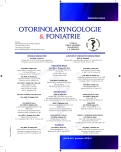Hearing Screening in Children of First Class of Elementary Schools in Hradec Králové
Authors:
Viktor Chrobok; L. Školoudík; M. Hloušková; L. Bilinová
Authors‘ workplace:
Klinika otorinolaryngologie a chirurgie hlavy a krku, Fakultní nemocnice Hradec Králové, Lékařská fakulta v Hradci Králové, Univerzita Karlova v Praze, přednosta prof. MUDr. V. Chrobok, CSc., Ph. D.
Published in:
Otorinolaryngol Foniatr, 63, 2014, No. 4, pp. 212-215.
Category:
Original Article
Overview
Introduction:
The hearing screening of children at the preschool and school age investigated, whether the children suffer from hearing loss, which might hamper development of speech and education. The main goal of the study was to diagnose hearing disorders in children beginning the compulsory education. The secondary aims of the study included determination of prevalence of hearing impairment in a population of children of the first classes of elementary schools, the prevalence of secretory otitis (OMS) and the establishment of the type and cause of the hearing impairment.
Methods:
The hearing screening examination included two parts. The first examination of audiometry was performed in the elementary schools and included the frequencies on 0.5, 1, 2 and 4 kHz at the intensity of 20 dB HL. The second examination included the basic ORL examination, standard tone audiometry and tympanometry.
Results:
Prevalence of hearing impairment in children of the first classes of the elementary schools was 2.3% (21 out of 913 children in all schools) or 3.1%(21 of 669 really examined children). A significant hearing impairment was determined in 8 children (0.9 % z 913 or 1.2 % of 669 children). OMS prevalence was established in 15 children 1.6 % of 913 children of the 1st classes of elementary schools or 2.2 % of 669 children examined. The most frequent case of hearing loss in our cohort proved to be OMS in 15 children (71.4% of the 21 children with hearing impairment). The other causes included dysfunction of the auditory tube in two children (9.2%), transitory hearing impairment with normal pressure conditions in the middle ear in three children (14.3%) and perceptual hearing loss in one child (4.8%).
Discussion:
The screening study diagnosed hearing impairment in two to three percent of children in the first classes of elementary schools, basically there was one percent of clinically important hearing impairment. Considering the high frequency of hearing impairment the authors suggest that a legislation measure of hearing screening should be introduced in children at the preschool age and at the beginning of the school attendance. The pediatrician should recommend audiometric examination of hearing and monitor the results. The otolaryngologist should be in charge of audiometric examination.
Keywords:
hearing screening, audiometric examination, school age children
Sources
1. Bamford, J., Fortnum, H., Bristow, K. et al.: Current practice, accuracy, effectiveness and cost-effectiveness of the school entry hearing screen. Health. Technol. Assess., 32, 2007, 11, s. 1-168.
2. Bristow, K., Fortnum, H., Fonseca, S., Bamford, J.: United Kingdom school-entry hearing screening: current practice. Arch. Dis. Child., 93, 2008, 3, s. 232-235.
3. Halloran, D. R., Hardin, J. M., Wall, T. C.: Validity of pure-tone hearing screening at well-child visits. Arch. Pediatr. Adolesc. Med., 163, 2009, 2, s. 158-163.
4. Kabátová, Z., Profant, M. et al.: Audiológia. Grada publishing, Bratislava, 2012, s. 181-182.
5. Kam, A. C., Li, L. K., Yeung, K. N., et al.: Automated hearing screening for preschool children. J. Med. Screen., 21, 2014, 2, s. 71-75.
6. Wu, W., Lü, J., Li, Y. et al.: A new hearing screening system for preschool children. Int. J. Pediatr. Otorhinolaryngol., 78, 2014, 2, s. 290-295.
Labels
Audiology Paediatric ENT ENT (Otorhinolaryngology)Article was published in
Otorhinolaryngology and Phoniatrics

2014 Issue 4
Most read in this issue
-
Anomaly of the First Branchial Cleft
(Cysts, Fistulas, Sinuses) - Mucosal Pemphigoid – Diagnostic Obstacles
- The Role of Sialoendoscopy in Mini Invasive Therapy of Sialolithiasis
- Possibilities of Surgical Use of Thulium Laser in Otorhinolaryngology of the Child Patients
